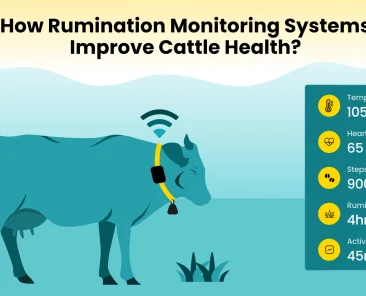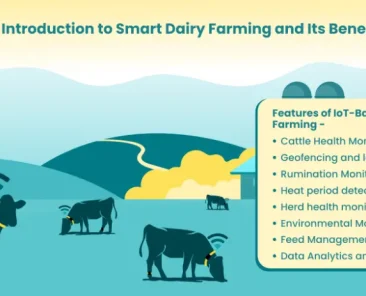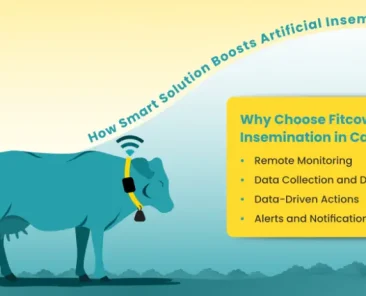The use of smart technology has transformed the management of animal health. Farmers can keep an eye on animal activity in real-time with livestock monitoring, especially through rumination tracking, which…
- Home
- Cow Health Monitoring
- 5 Benefits of Choosing Virtual Fencing for Cattles
5 Benefits of Choosing Virtual Fencing for Cattles
- Categories: Cow Health Monitoring
Get in Touch
Related Blogs
Dairy farming is an important aspect of agriculture, and “smart dairy farming” might sound like an oxymoron, but it is a reality now. Large dairy farms with more than 100…
This blog aims to explain how a smart cattle monitoring system assists in successful artificial insemination in cattle. Artificial insemination is a practice followed by dairy farms to achieve higher…
Virtual fencing for cattles is a technology that has emerged recently to assist farmers in livestock management. We all are very well aware of the term fencing. Traditionally, cattles are…
Virtual fencing for cattles is a technology that has emerged recently to assist farmers in livestock management.
We all are very well aware of the term fencing. Traditionally, cattles are managed and prohibited from roaming away by building a defined boundary, i.e., fencing. But building fences and maintaining fences is a very labor-intensive and costly task.
Contrary to physical fences, virtual fencing solutions emerged in the market, that offer virtual boundaries to protect cattles but also let them roam freely and have a fresh feed.
Fitcows cattle tracking and monitoring system comes with a virtual fencing feature so, let us explain how it works and why this feature is important for the cattle farming business.
What is Virtual Fencing for Cattles?
Virtual fencing is an animal-friendly fencing system that controls animals without any ground-based fencing and allows animals like cattles to graze without any restriction of fixed boundaries while still keeping them confined. This technology allows farmers to draw a virtual boundary and track their herd movement in real time. Also, if a cattle moves beyond the virtual boundary the farmers will receive an alert.
This technology uses GPS technology and smart collars to remotely track cattles by creating virtual boundaries.
Moreover, it is considered and proven that it reduces the cost of physical fences that are spread over the entire landscape. Reduces fuel load, and is also best suited for practicing rotational grazing.
Fitcows cattle monitoring system also comes with a virtual fencing feature, making the solution act like a remote shepherd for your herd.
Past and Present of Virtual Fencing
Till now, multiple people and organizations have contributed to the development of a perfect virtual fencing system.
First, it was in 1980 when Dean Anderson, a USDA scientist, came up with the idea of virtual boundaries while researching cattles.
Later, Craig Hale and Anderson developed a prototype of a virtual fence that uses an audio interface to guide cattles on which way to move.
After that, several companies developed virtual fencing systems and perfected this technology.
Fitcows’ Cattle Tracking system allows the farmers to draw boundaries of any kind of geometrical shapes, and though the boundaries can not be seen by the naked eye, it can be detected by the smart collar worn by the cattles.
Moreover, The system uses radio frequency signals emerging from GPS satellites to generate virtual boundaries. Algorithms within the smart system use GPS data and other similar data to determine the accurate cattle location.
Benefits of Having Virtual Fencing for Cattles

Other than the benefits of saving labor cost and physical fencing costs, some more advantages of implementing virtual fencing in dairy farming businesses are:
- Cattles can be excluded from grazing in certain areas, like the crop fields, burned areas, or areas that are too wet.
- Monitoring individual animal
- Implementing rotational grazing becomes easier.
- Virtual fences can be remotely controlled which means, the fencing can be customized or removed at any time from anywhere. Plus, virtual fencing can be of any shape and size.
- If a cattle moves beyond the marked parameter, the system will provide an alert on mobile phones and give an exact location of the cattle.
With GPS-enabled smart collars and a powerful gateway, Fitcows cattle monitoring system allows farmers to track their herds 24/7 from anywhere.
In addition to fencing, our developed smart system also allows ranchers to detect sick/injured cattles.
Why Choose Fitcows to Integrate Virtual Fencing in Cattles?
Fitcows cattle monitoring system is the best solution for your dairy farming business because other than only virtual fencing the Fitcows solution offers a wide range of features that solve A to Z all problems faced by the farmers managing cattles.
The list of features offered by Fitcows cattle monitoring system are:
- Movement tracking
- Rumination monitoring
- Accurate cow health monitoring
- Breeding Insights & Heat period detection
- Animal behavior monitoring
- Milk yield and quality monitoring
- Vaccination alerts
Get a free demo of Fitcow’s smart cattle monitoring system and see for yourself how it works.
FAQs
What is the virtual fence for cattle?
Virtual fence for cattle is a technology that uses GPS-enabled smart collars to keep the livestock within set virtual boundaries while they graze on an open field.
What are the advantages of virtual fencing?
The advantages of virtual fencing include:
- Reduced costs as virtual fencing is more economical than traditional fencing.
- Virtual fencing will also eliminate wildlife conflicts, as there’s no physical boundary.
- It improves animal health as farmers can change the fence daily.
- The smart system gives farmers more control over the grazing activity of their cattles.
How does virtual fencing work for cattle management?
Virtual fencing in cattle management uses smart collars to monitor and track the movement of livestock in near real time. So, in a virtual fencing system, the farmers set the fencing boundary digitally on mobile screens. Now, if a cattle wearing a smart collar crosses the virtual boundary, an alert is sent to the farmers so that they can take timely action.
Is virtual fencing safe for cattle?
Get in Touch
Related Blogs
The use of smart technology has transformed the management of animal health. Farmers can keep an eye on animal activity in real-time with livestock monitoring, especially through rumination tracking, which…
Dairy farming is an important aspect of agriculture, and “smart dairy farming” might sound like an oxymoron, but it is a reality now. Large dairy farms with more than 100…
This blog aims to explain how a smart cattle monitoring system assists in successful artificial insemination in cattle. Artificial insemination is a practice followed by dairy farms to achieve higher…
Virtual fencing for cattles is a technology that has emerged recently to assist farmers in livestock management. We all are very well aware of the term fencing. Traditionally, cattles are…




